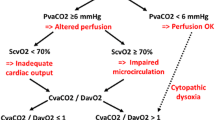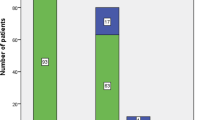Abstract
Objective
To define sepsis and septic shock in children, to outline an approach to treatment in the emergency, critical care units and to outline a global sepsis initiative.
Methods
A synopsis of the literature and adaptation of current treatment guidelines for sepsis in children.
Results
Sepsis in children can be recognized early using clinical parameters. Prompt, aggressive treatment using ACCM guidelines has resulted in improved outcomes.
Conclusion
A collaborative approach to the diagnosis and treatment of sepsis by the Emergency Department and Pediatric Intensive Care Unit can lead to improved outcomes of children with sepsis. Treatment based on a model of escalating levels of care and organ support which takes into consideration the resources available in different settings is likely to improve sepsis outcomes globally. The World Federation Sepsis Initiative (www.wfpiccs.org) is intended to promote treatment based on this model.
Similar content being viewed by others
References
Levy MM, Fink MP, Marshall JC, Abraham E, Angus D, Cook D et al. 2001 SCCM/ESICM/ACCP/ATS/SIS International Sepsis Definitions Conference. Crit Care Med 2003; 31: 1250–1256.
Carcillo JA, Fields AI. Clinical practice parameters for hemodynamic support of pediatric and neonatal patients in septic shock. Crit Care Med 2007; 30: 1365–1378.
Goldstein B, Giroir B, Randolph A. International pediatric sepsis consensus conference: definitions for sepsis and organ dysfunction in pediatrics. Pediatr Crit Care Med 2005; 6: 2–8.
Brealey D, Brand M, Hargreaves I, Heales S, Land J, Smolenski R et al. Association between mitochondrial dysfunction and severity and outcome of septic shock. Lancet 2002; 360: 219–223.
Xia ZF, He F, Barrow RE, Broemeling LD, Herndon DN. Reperfusion injury in burned rats after delayed fluid resuscitation. J Burn Care Rehabil 1991; 12: 430–436.
Annane D, Bellissant E, Cavaillon JM. Septic shock. Lancet 2005; 365: 63–78.
Trzeciak S, Rivers EP. Clinical manifestations of disordered microcirculatory perfusion in severe sepsis. Crit Care 2005; 9: S20–S26.
Ince C. The microcirculation is the motor of sepsis. Crit Care 2005; 9: S13–S19.
Protti A, Singer M. Bench-to-bedside review: potential strategies to protect or reverse mitochondrial dysfunction in sepsis-induced organ failure. Crit Care 2006; 10: 228.
Ceneviva G, Paschall JA, Maffei F, Carcillo JA. Hemodynamic support in fluid-refractory pediatric septic shock. Pediatrics 1998; 102: e19.
Wills BA, Nguyen MD, Ha TL, Dong TH, Tran TN, Le TT et al. Comparison of three fluid solutions for resuscitation in dengue shock syndrome. N Engl J Med 2005; 353: 877–889.
Ranjit S, Kissoon N, Jayakumar I. Aggressive management of dengue shock syndrome may decrease mortality rate: a suggested protocol. Pediatr Crit Care Med 2005; 6: 412–419.
Maitland K, Pamba A, English M, Peshu N, Marsh K, Newton C et al. Randomized trial of volume expansion with albumin or saline in children with severe malaria: preliminary evidence of albumin benefit. Clin Infect Dis 2005; 40: 538–545.
Han YY, Carcillo JA, Dragotta MA, Bills DM, Watson RS, Westerman ME et al. Early reversal of pediatric-neonatal septic shock by community physicians is associated with improved outcome. Pediatrics 2003; 112: 793–799.
Ninis N, Phillips C, Bailey L, Pollock JI, Nadel S, Britto J et al. The role of healthcare delivery in the outcome of meningococcal disease in children: case-control study of fatal and non-fatal cases. BMJ 2005; 330: 1475.
Oliveira CF, Carcillo JA, Oliveria DSF, Troster E, Voz F. An outcomes comparision between ACCM-PALS implementation with and without continuous SCVO2 monitoring for Pediatric Septic Shock. Pediatr Crit Care 2007; A171: 22.2.873.
Verbruggen SCAT BC, de Hoog M, Hazelzet JA, Joosten KFM. Are we getting better? Dramatic changes in mortality in children with sepsis and purpura in Rotterdam. Europediatrics 2006; 236.
Zaritsky AL, Hickey RW, Schexnayder SM, Berg RA, eds. Pediatric Advanced Life Support Provider Manual. Dallas, TX: Heart Association, 2002.
Pollack MM, Fields AI, Ruttimann UE. Distributions of cardiopulmonary variables in pediatric survivors and nonsurvivors of septic shock. Crit Care Med 1985; 13: 454–459.
Rivers E, Nguyen B, Haystad S, Ressler J, Muzzin A, Knoblich B et al. Early goal-directed therapy in the treatment of severe sepsis and septic shock. N Engl J Med 2001; 345: 1368–1377.
Foland JA, Fortenberry JD, Warshaw BL, Pettignano R, Merritt RK, Heard ML et al. Fluid overload before continuous hemofiltration and survival in critically ill children: a retrospective analysis. Crit Care Med 2004; 32: 1771–1776.
Nguyen TC, Liu A, Liu L, Ball C, Choi H, May WS et al. Acquired ADAMTS-13 deficiency in pediatric patients with severe sepsis. Haematologica 2007; 92: 121–124.
Fortenberry JD, Paden ML. Extracorporeal therapies in the treatment of sepsis: experience and promise. Semin Pediatr Infect Dis 2006; 17: 72–79.
Kumar A, Roberts D, Wood KE, Light B, Parrillo JE, Sharma S et al. Duration of hypotension before initiation of effective antimicrobial therapy is the critical determinant of survival in human septic shock. Crit Care Med 2006; 34: 1589–1596.
Schonberger W, Grimm W, Gempp W, Dinkel E. Transient hypothyroidism associated with prematurity, sepsis, and respiratory distress. Eur J Pediatr 1979; 132: 85–92.
Butt W. Septic shock. Pediatr Clin North Am 2001; 48: 601–625.
Author information
Authors and Affiliations
Corresponding author
Rights and permissions
About this article
Cite this article
Skippen, P., Kissoon, N., Waller, D. et al. Sepsis and septic shock: Progress and future considerations. Indian J Pediatr 75, 599–607 (2008). https://doi.org/10.1007/s12098-008-0116-4
Received:
Accepted:
Published:
Issue Date:
DOI: https://doi.org/10.1007/s12098-008-0116-4




